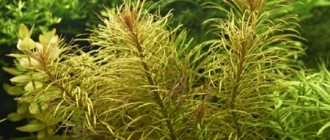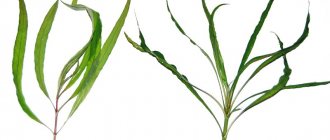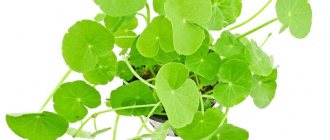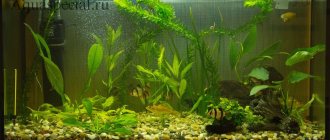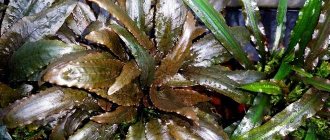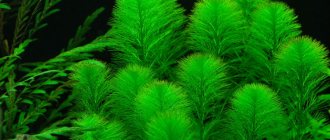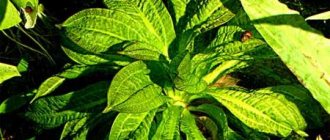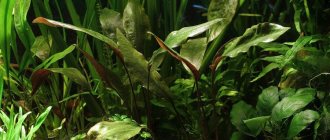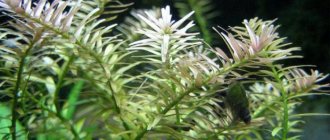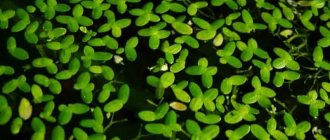5
(6)
Today there are incredibly many varieties of underwater flora. Moreover, naturalists discover new species almost every day. Some families are even represented in a wide variety, and therefore are very popular among both beginners and experienced aquarists. Pogostemon can also be classified as such.
Description
Essentially, this is a large group of aquatic plants. In nature, they are found in wetlands and river backwaters. The natural habitat is India, Australia and all of Southeast Asia.
Most of the species have similar external characteristics: a tall stem, a creeping root, narrow and long leaves. The color of the plant depends on the conditions of its maintenance. With intense light and a large amount of organic matter, the bushes can turn yellow or even red. In low light they remain green.
Pogostemon is a rather demanding plant family. To successfully maintain them, you need good lighting, additional fertilizers, high-quality soil, stable water parameters, etc.
Appearance
It has 8 leaflets in a whorl of a very elongated shape - approximately 4x1 mm. The shoots are erect, the color is green with a slight purple tint. It grows at an average speed, is unpretentious in terms of fertilizers, but does not tolerate muddy water well. Looks great in the background of a man-made underwater landscape or in its center, as a spectacular decoration for its inhabitants. Forms bright and attractive combinations with red and purple aquatic grasses.
Photo gallery of Pogostemon Erectus:
Maintenance and care in the aquarium
This plant can be found in the aquariums of mainly experienced hobbyists who know under what conditions the bushes can survive and are able to provide everything necessary to preserve the natural beauty of this underwater flora.
Pogostemon helferi
In general, the content depends on the variety, but common features that are characteristic of most species can be identified:
Water parameters . According to this indicator, most plants are absolutely picky. Temperature can vary from 15 to 30 degrees, acidity - 5-7 pH, hardness - 1-30 dGH (however, some species like soft water). But what is much more important is not the parameters themselves, but their stability. Many species prefer old, established aquariums in which the water characteristics do not change. In newly launched reservoirs, it will most likely not be possible to save the bush from death;
Lighting . Pogostemon is a light-loving plant, so it, accordingly, needs to provide this need. In order for the bushes to develop well, at the highest possible rate for them, they need good intensity and long daylight hours. As a rule, 0.5-1 W/l is enough (depending on the type), and for the lamp to work 10-12 hours a day;
Soil . Both fine and medium-sized substrates such as sand, pebbles, quartz, etc. are suitable. In addition, some species (for example, helfera) do not need soil at all. They can be attached to snags and rocks. But it is worth considering that pogostemon is found in nature in wetlands. Therefore, at home, it is advisable to ensure that the substrate is silted, but within normal limits;
Additions .
Natural nutrients are not enough to grow these plants successfully. Therefore, it is advisable to add macroelements (if tests show that there are few of them) or separately potassium, as well as microelements, when turning on the light. It will not be superfluous to supply carbon dioxide, which will help strengthen the plants and accelerate their growth.
Mr. Tail Recommends: Aquarium Basics
Keeping Pogostemon Erectus in an aquarium is extremely simple and hassle-free. It grows at high speed in well-lit spaces without shade from other algae. In the twilight, as a rule, he stretches out and looks downright shabby. Daylight hours for this native of the Indian tropics should be 10-12 hours, not without the help of special lamps. It is better to cut it once every two weeks, giving the young stems access to light. When pruned, the bush actively produces lateral branches, forming dense thickets.
Loves soft water enriched with carbon dioxide, approximately from 5 to 12 mg/l (preferably closer to 12).
Optimum temperature – +20 °C, pH – from 5.0 to 7.5.
A layer of soil - ideally, fine quartz or pebbles, will require at least 5 or 7 cm. The bush has a powerful root system.
The water needs to be changed regularly, by one third approximately once a week. He prefers nitrogen fertilizers; when they are used, he becomes more luxuriant and brighter.
Kinds
This plant has a wide classification. But still, only some types of pogostemon are especially popular.
Erectus (Pogostemon erectus)
A beautiful plant with a long stem. Visually, it slightly resembles a Christmas tree. On one whorl there are about eight elongated leaves up to 4 cm. The growth rate is average. The bush can reach 40 cm in height, so it is more suitable for large aquariums and is planted in them near the back wall.
If the light intensity is high, the plant quickly grows upward and, in order to maintain its beauty, it needs to be trimmed regularly. The stems should be selected selectively, those that cover the young shoots.
Water parameters are standard. Temperature - 22-27 degrees, acidity - 6.5-8, hardness - 6-8. Erectus really does not like cloudy water, so filtration should be powerful and water changes should be regular. It is not demanding when it comes to fertilizing and has good endurance.
Helfera (Pogostemon helferi)
This plant is distinguished by curly leaves and small size. The leaves have a rich green tint. In good light it grows quickly, sending out side shoots. Pogostemon helfera is not considered a groundcover, but the new bushes are packed very tightly together, creating an attractive carpet in the foreground.
The helfera reaches a height of no more than 15 cm. Loves bright lighting with an intensity of 0.5-1.0 W/l. In low light, the bushes will not die, but will lose their attractiveness.
This species prefers “adult” aquariums with stable water parameters. The soil must be nutritious, since the plant receives most of its nutrients through the roots. It is also advisable to apply fertilizers, but you need to carefully monitor the organic content in the aquarium. If you provide good conditions, then with the help of a helfer you can easily decorate an aquarium, because it can also be planted on decorations such as driftwood.
Stellatus octopus (Pogostemon stellatus sp. "Octopus")
An original species, characterized by narrow and long leaves. It is called an “octopus” because its leaves develop due to the current and thus resemble tentacles.
An adult bush can reach 60 cm in height, and in a fairly short time. However, the plant calmly survives pruning and is, in principle, unpretentious. The sheets are 9 cm long and only 0.6 mm wide. Loves clean and oxygenated water. Propagated by cuttings.
Kimberley (Pogostemon sp. Kimberley)
Appeared in the aquarium hobby relatively recently, around 2012. This is an unusual look with high aesthetic properties. The leaves are narrow, with a jagged edge. In good light they become pinkish-brown in color.
The plant looks great in the center or foreground. It’s not particularly fussy about lighting and water parameters. But, of course, in water rich in microelements with a good lamp, it becomes as beautiful and rich as possible.
But at the same time, Kimberly loves nutritious soil. Therefore, when planting, it is advisable to use special tablets that are placed under the root. But you should also take into account that this is a fragile species, so you need to be careful when transplanting it.
Pogostemon Erectus: features and basics of content
Pogostemon erectus is an algae of the Lamiaceae family that has gained popularity among aquarists around the world. This species is native to India and looks like a lush and colorful tropical conifer. Only in miniature - approximately 40 cm in height and 15 in width. A forest of such bright green “Christmas trees” in an aquarium or paludarium is not only beautiful in itself, but will also become an excellent environment for fish.
Plant care
Pogostemon erectus is characterized by medium complexity of maintenance. For it, it is necessary to organize sufficient lighting, good filtration, regularly change the water, feed it with complex fertilizers and sometimes cut it, giving the bush the desired shape.
A haircut
To maintain compact group sizes, some aquarists regularly trim thickets of Pogostemon erectus, cutting off too long stems by about a third. Some time after cutting, the plant begins to produce side shoots. As a result, the bush takes on a more decorative appearance, becomes lush and compact.
Top dressing
Pogostemon erectus should be regularly fed with liquid fertilizers containing nitrogen. By receiving important trace elements and minerals from the aquatic environment, the plant becomes stronger and more actively forms side shoots. You can also bury small pieces of clay in the soil to feed the plant.
Filtration
Successful breeding of Pogostemon erectus requires filtration and regular water changes. In an aquarium without a filter, the leaves and stems of the fluffy Christmas tree become covered with a slippery coating, which impedes the plant’s gas exchange. Every 10-15 days, 10-30% of the water in the aquarium should be replaced, this will keep the aquatic environment clean and fresh.
Compatibility with fish and other aquarium inhabitants
Due to the presence of succulent leaves, the plant attracts the attention of herbivorous fish and snails.
Herbivorous fish include some cichlids and aquarium catfish. Therefore, if you have herbivorous inhabitants in your aquarium, be prepared for the fact that it will quickly lose its attractive appearance.
If you want to preserve the beauty of the plant, plant it in an aquarium with predators. In addition, pogostemon gets along well with shrimp, as they will clean its foliage of small algae.
Compatible fish also include tetras, neon fish, labyrinth fish and goldfish. But the plant does not get along with cichlids, barbs, guppies, and mollies.
Did you know? Octopus is able to change the width of the leaves depending on the degree of illumination. Thanks to this feature, it is included in the group of unique plants.
This plant requires more careful care than many others, but the results are worth the effort. By planting an octopus in your aquarium, you will enliven and decorate the underwater landscape.
If you carefully care for your pogostemon, it will delight you for a long time with its bright colors and the unusual beauty of its graceful leaves.
Pogostemon octopus - aquarium plant
Pogostemon octopus (from the English pogostemon octopus) is the most common plant in the waters of Australia and Southeast Asia, which was brought to our region from there. Pogostemon octopus began to be closely propagated relatively recently - just over 10 years ago, but even now this species is the most common decoration of modern aquariums. However, it is worth noting that the plant is quite finicky and requires proper care and maintenance, so it is recommended that only knowledgeable and competent aquarists keep it.
The plant Pogostemon octopus is formed in the form of long narrow green leaves. It received the name “octopus”, which translates as “octopus”, not by chance. The leaves cannot stay still when planted close to an aquarium filter; they move like octopus tentacles. When approaching the light, the tops of the octopus acquire a red-brown color. The length of an adult plant can reach 60 centimeters and the width – 25 centimeters. Despite its considerable size, Pogostemon octopus does not interfere with the development of other types of vegetation, since its thin stems do not create much shade.
Appearance
Pogostemon erectus is a bush on a straight stem up to 40 cm high. Because of the stem, it received the name: erectus, i.e. "upright". The width of the bush can reach up to 15 cm, which is a lot for an aquarium.
The leaves are thin, densely growing, reminiscent of young needles. As already mentioned, the density of the foliage and the richness of its color depend on the growing conditions. In fertilized soil, the plant retains the bright green color of its “needles,” which take on violet tones in good light. In dim light, the foliage becomes pale.
The graceful foliage of Pogostemon erectus suits the purple and red aquarium flora perfectly.
Planting and propagation
It is advisable to plant pogostemon in soil saturated with elements, one cutting per hole, maintaining a certain distance. If planted frequently, the lower leaves will not receive the necessary light.
The stems of the plant are quite fragile, so during planting you should be careful not to break them.
Propagated by separating side shoots and tops. You can choose any option convenient for yourself, following the following sequence:
- use scissors to cut off a shoot 10-15 cm long;
- then make a hole in the ground and place a piece of clay there;
- Then lower the base of the seedling into the hole, covering it with soil without tamping.
The shoots can be replanted if they have grown at least three rows of leaves. Periodically cut off the top part of the bush so that it sends out side shoots, becoming lush, and does not stretch out. When the octopus grows, it is advisable to thin it out and replant the resulting shoots. When the bush ages and the trunk becomes bare, cut it off and plant it in the ground.
Convenience and beauty rolled into one
Getting cute “Christmas trees” in an artificial pond is not particularly difficult. This plant is unpretentious in maintenance; it is enough to create an aquatic environment of low hardness with a temperature of 20 to 28 degrees and the obligatory presence of carbon dioxide. The development of Pogostemon erectus directly depends on illumination:
- in bright light for 12 hours, its growth rate slows down, and new leaves and stems acquire a pinkish tint;
- when there is a lack of light, the plant tends to stretch upward and needs frequent pruning, which leads to compaction of the group due to the quickly appearing side shoots.
Due to the rather powerful root system, Pogostemon erectus is best planted in the ground with a layer of at least 5-7 cm, consisting of small pebbles and sand (quartz); It would not be superfluous to periodically fertilize with nitrogen or complex liquid fertilizers. Growing new bushes is generally simple: just separate a side shoot from the trunk of an existing plant and plant it in the chosen location; rooting occurs quickly and without problems.
We suggest you read: Proper keeping of hedgehogs in a city apartment, how to get along with a prickly friend
